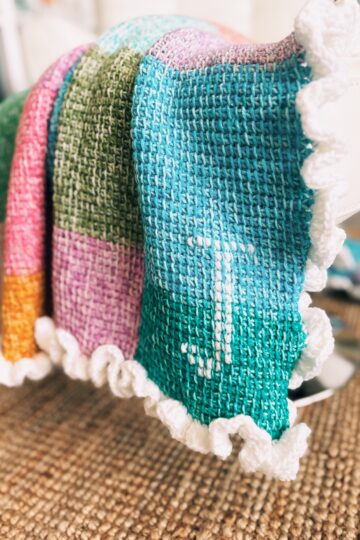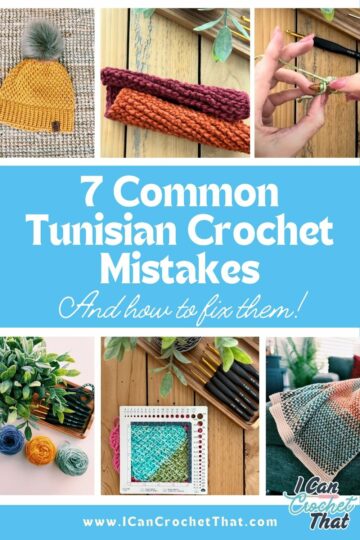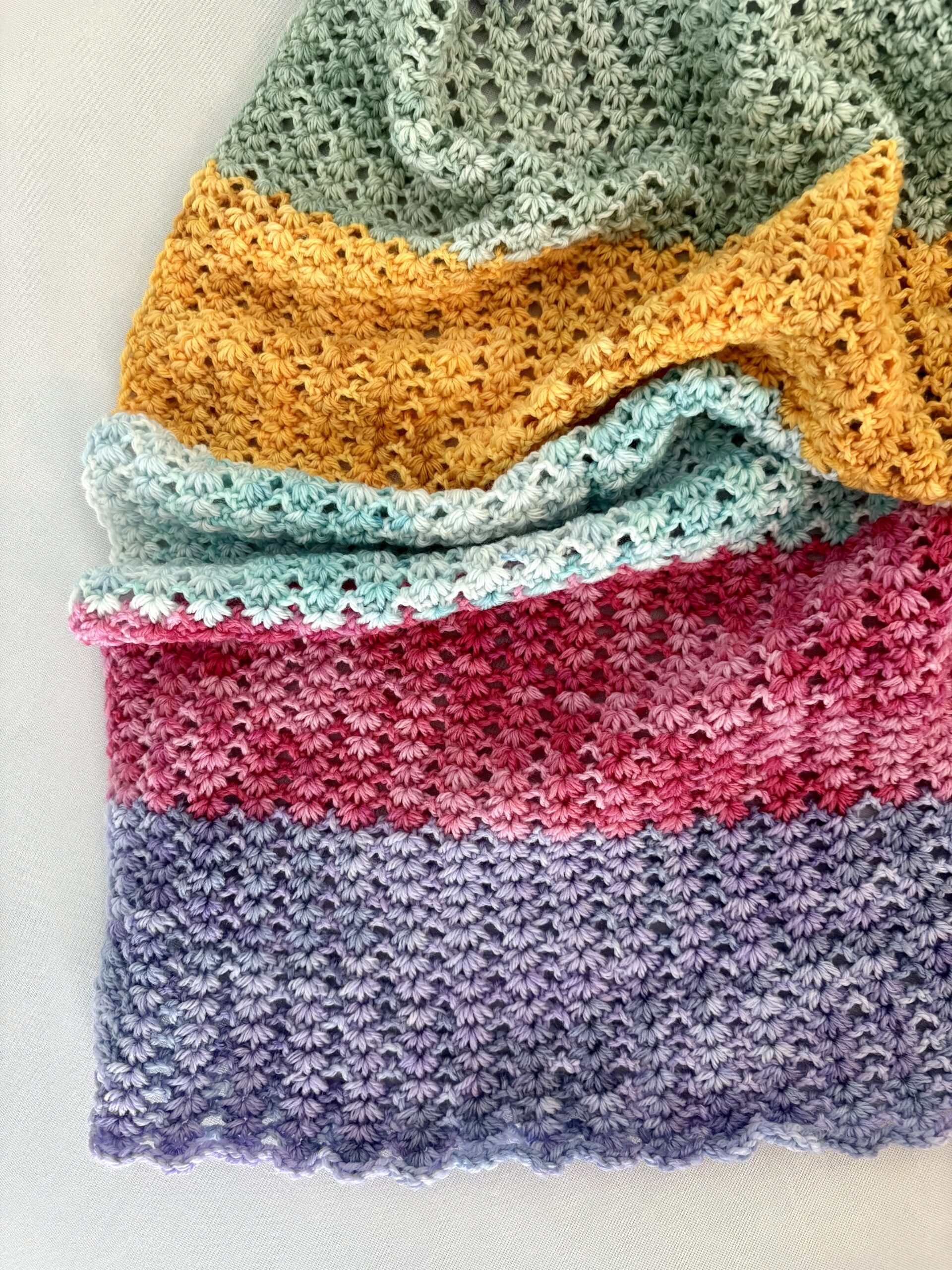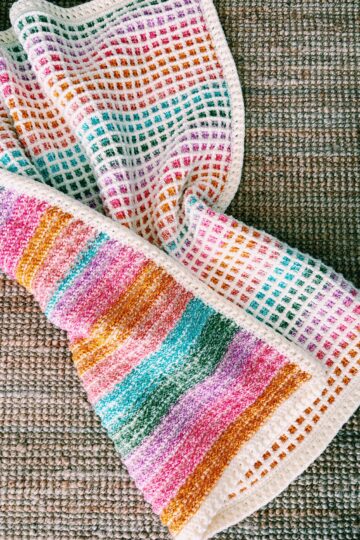While I probably could have squeezed the topic of the difference between Tunisian crochet and regular crochet into one of my existing Tunisian crochet articles, I figured it deserved its own post.
Why? Because I get this question a lot!
And I had the same question when I first started out. So if you're a beginner, I hope this article clears up any questions you have about the difference between these two types of crochet.
Let's dive in, shall we?
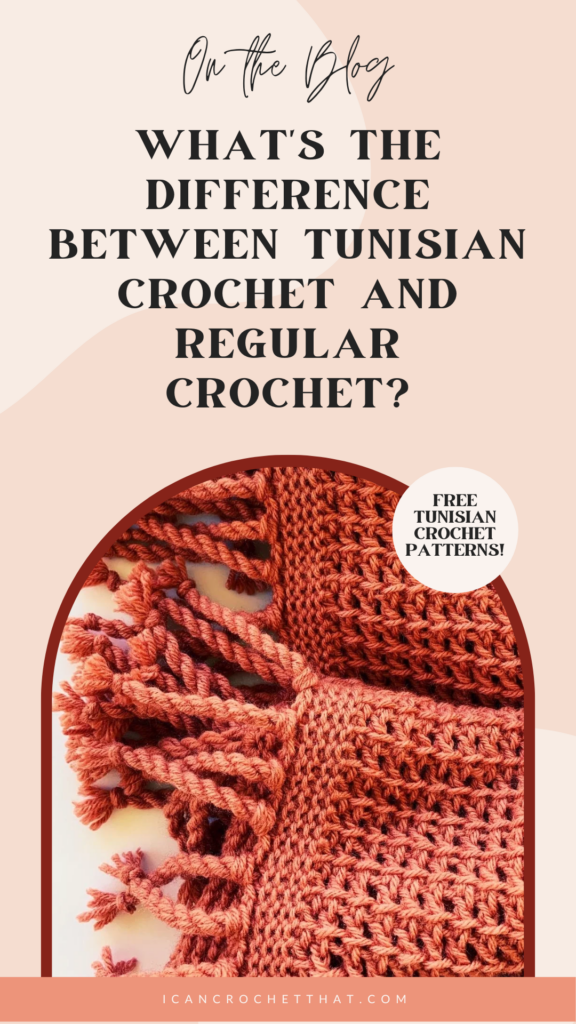
Understanding the Basics: What Sets Tunisian Crochet Apart
Tunisian crochet and regular crochet differ in tools, technique, and resulting fabric. Tunisian crochet requires a longer hook and involves working a row of stitches onto the hook in a 'forward pass', then off in a 'return pass'. This creates a denser, woven-like fabric, unlike the more lacy texture of regular crochet.
As crafters, we all know how exciting it can be to discover a new technique, and Tunisian crochet is one such gem in the crochet world that offers a fresh and unique experience! I still remember trying it for the first time. I'll be honest...it was really frustrating and I almost gave up!
But I am so glad I didn't because it has turned into my all-time favorite fiber craft. Basically, I'm addicted. 🙂
So, what exactly makes Tunisian crochet stand out? Let's delve into that.
Unique Characteristics
First and foremost, Tunisian crochet, sometimes referred to as Afghan crochet, differs significantly from regular crochet in how the stitches are formed.
Instead of working one stitch at a time and completing it before moving on to the next (as we do in regular crochet), Tunisian crochet involves working a whole row of stitches onto the hook on a 'forward pass,' then working them all off again on a 'return pass.'
This creates a rich, woven-like fabric that's very distinctive.
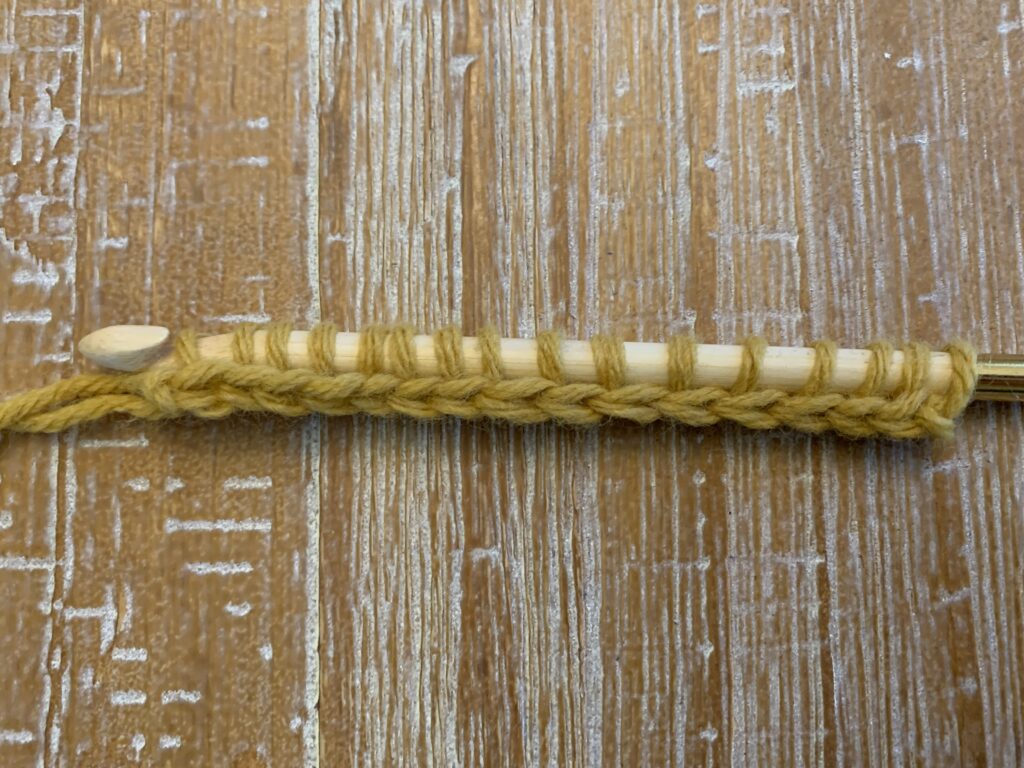
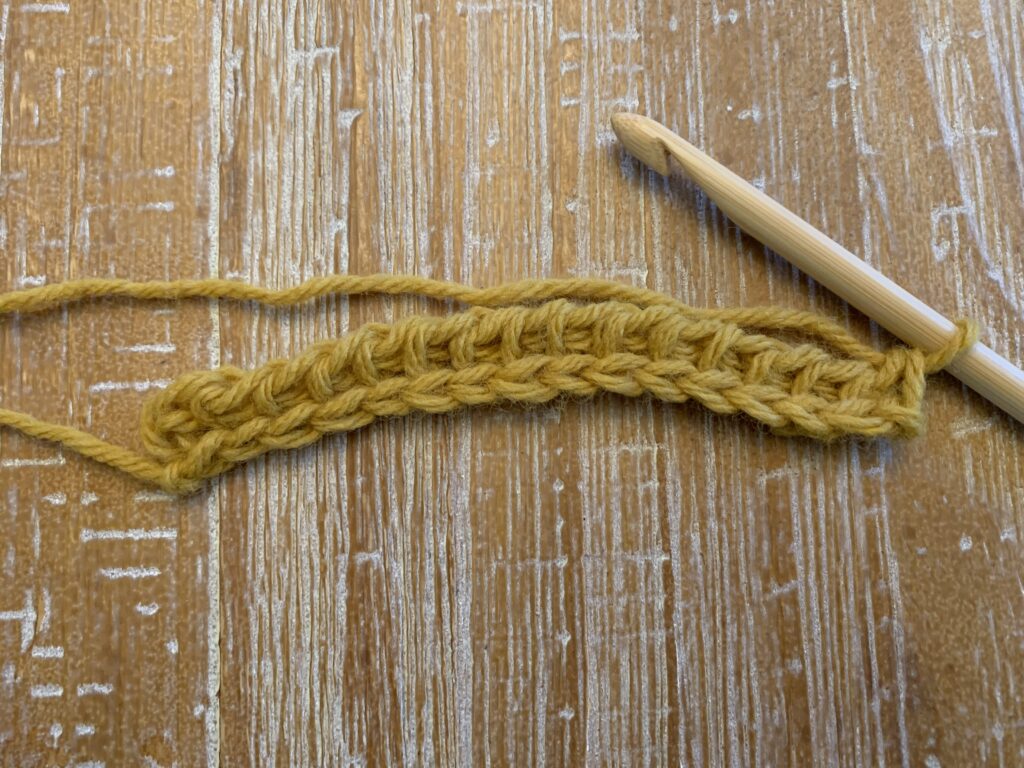
Tools of the Trade
You'll also notice the crochet hooks used in Tunisian crochet are a bit different from our regular crochet hooks.
They are much longer to accommodate an entire row of stitches, and for larger projects, you might even find yourself working with a hook that has a cable attached.
The hooks also lack the thumb rest that regular crochet hooks usually have. It's a bit of an adjustment, but once you get the hang of it, you'll appreciate its unique possibilities!
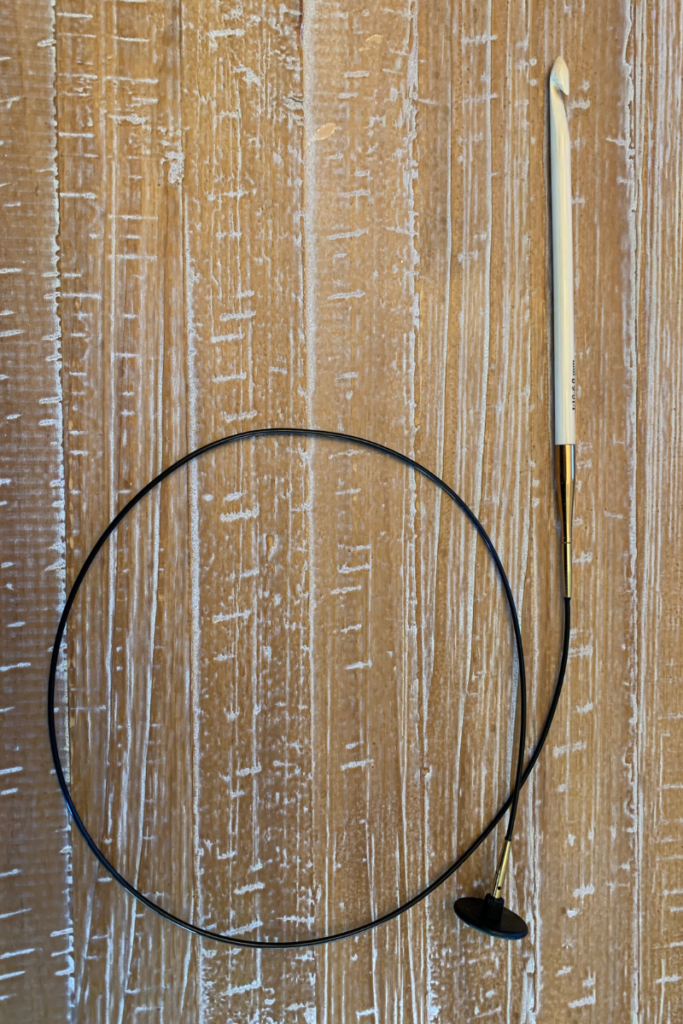
Here are a few of my favorite Tunisian crochet hooks with the cable:
- Knitter’s Pride Bamboo Hooks Set
- Knitter’s Pride Dreamz Set
- Clover Interchangeable Tunisian Crochet Hook “Takumi” Combo Set – My current favorite because the cord swivels
- Tulip Carry T Interchangeable Bamboo Tunisian Hook Set – This set has a size 7mm hook which some of my patterns call for. For some reason, that size is very hard to find.
The Tunisian Texture
Finally, let's talk about the incredible texture.
With its unique stitch structure, Tunisian crochet offers a denser, less stretchy fabric compared to regular crochet. It has a gorgeous, woven quality that's not typically found in other crochet techniques.
And don't get me started on the beautiful patterns you can create with colorwork in Tunisian crochet – they're simply breathtaking!
My favorite patterns are the ones I created that mix two different yarn weights like the Bryn blanket and the Ethan blanket.
The Bryn blanket is made with the Tunisian full stitch and the Ethan blanket is made with the Tunisian smock stitch. Both are gorgeous using one color or two!
So, as you can see, Tunisian crochet is its own special corner of the crochet world, offering a unique crafting experience.
But how does it compare directly to regular crochet stitches? Let's dive into that in our next section!
3 Key Differences Between Tunisian Crochet and Regular Crochet Stitches
The wonderful world of crochet is filled with all sorts of stitches, each bringing its own charm to our projects. But the stitch differences really stand out when it comes to Tunisian crochet versus regular crochet.
Let's explore three key differences between the stitches used in these two techniques.
The Forward and Return Method
One fundamental difference is how the stitches are worked. In regular crochet, we insert the hook into a stitch, yarn over, pull through, and complete the stitch. Pretty simple, right?
However, Tunisian crochet introduces us to a fascinating 'forward and return' method.
Instead of finishing one stitch at a time, we pick up loops for all the stitches across the row in the forward pass and then work them off the hook on the return pass. This two-step process lends Tunisian crochet its unique fabric quality.
The Unique Tunisian Stitches
We have some special stitches in Tunisian crochet that you wouldn't find in regular crochet.
For instance, the Tunisian simple stitch (TSS) creates a tight, woven fabric, while the Tunisian knit stitch (TKS) resembles knitting, and the Tunisian purl stitch (TPS) provides a lovely texture.
It's like having a new set of tools in your crochet toolbox!
The Visual Difference
Last but not least, the visual difference between Tunisian and regular crochet stitches is striking.
Our regular stitches, like single, half-double, double, and treble crochet, each have their unique appearance, but they tend to create a more lacy, open fabric.
On the other hand, Tunisian stitches are closer together, creating a more solid, woven-looking fabric. This is great for projects where you want less gaps and a more robust structure.
Understanding these differences will help you decide when to use Tunisian crochet versus regular crochet in your projects.
But the question remains - how different are the actual skills involved? That's what we'll tackle in the next section!
Mastering the Technique: How Tunisian Crochet Skills Differ
Moving from regular crochet to Tunisian crochet can feel like learning a new language. The terms are familiar, but the grammar and syntax? Totally different!
Let's look at how the skills we need for Tunisian crochet differ from those for regular crochet.
The Art of Holding the Hook
In regular crochet, we have a few different ways we might hold our hook - overhand, pencil grip, you name it.
But with Tunisian crochet, the game changes a little. Given the length of the hook and the number of loops you'll have on it, many people find it more comfortable to hold the hook like a knitting needle.
This overhand grip may feel a bit strange at first, especially if you're a pencil-grip kind of crocheter, but with practice, it'll become second nature!
I've been told I hold both my crochet hook and my Tunisian crochet hooks weirdly, but it gets the job done! 😉 Here's a video of me showing how to do the Tunisian smock stitch.
Picking Up Loops
One of Tunisian crochet's beauties (and challenges) is keeping all your loops on the hook.
Instead of working each stitch off as we go along, we pick up loops for every stitch in our row and keep them on our hook until the return pass.
This requires a bit of a mindset shift, and it means you have to pay a little more attention to your tension to ensure your work stays neat and even.
Precision and Attention to Detail
Since correcting mistakes in Tunisian crochet can be a bit more challenging than in regular crochet (no one likes frogging a whole row of stitches, right?), keeping a close eye on your work pays off.
Careful counting and making sure you're working into the correct loops can save you a world of frustration. Trust me on this one!
Mastering these skills can take your crochet journey to a whole new level. But, what can you actually make with Tunisian crochet? Let's explore some project ideas in our next section!
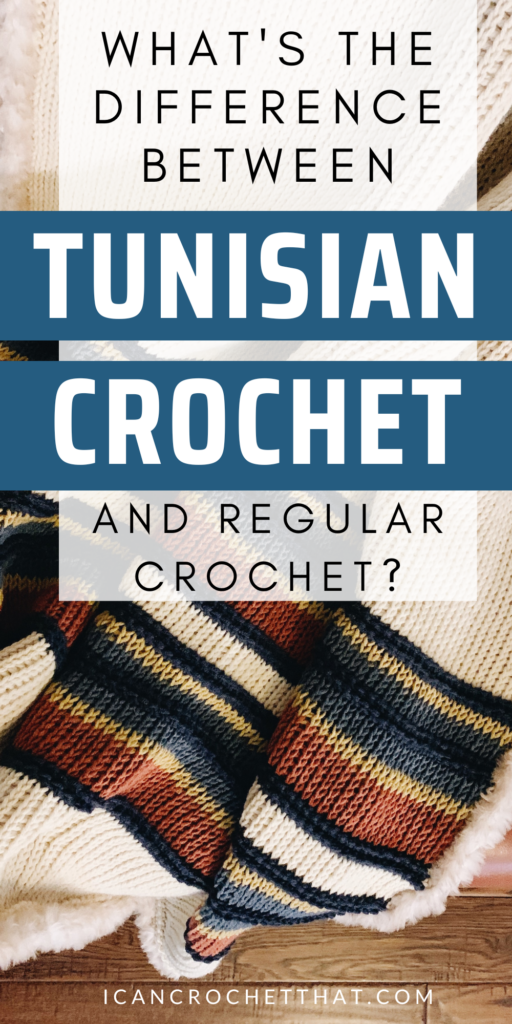
5 Fabulous Projects You Can Try With Tunisian Crochet
Now that we've covered the differences between Tunisian and regular crochet, you might wonder, "What can I make with Tunisian crochet?" The answer? So much!
Here are five fabulous projects that are perfect for showing off the unique beauty of Tunisian crochet.
Starting Small: Scarves, Dishcloths, or Placemats
If you're new to Tunisian crochet, starting with smaller projects like scarves and dishcloths can be a great way to get your feet wet.
The texture of Tunisian crochet makes for wonderfully warm scarves, and dishcloths are a practical way to practice new stitches.
Here are a couple of patterns to take a look at:
Tunisian crochet rectangle placemat pattern
Tunisian crochet scarf pattern
Moving Up: Blankets and Shawls
Once you're comfortable with the basics, blankets, and shawls are a fantastic way to show off the dense, warm fabric that Tunisian crochet creates. The larger canvas allows you to play with colorwork and different stitch patterns.
As you may have noticed, we're a wee bit obsessed with Tunisian crochet blankets around here! I won't list them all, but you can find most of them here.
Here are a few of my favorites, plus a shawl pattern:
Tunisian crochet wave stitch blanket pattern
Striped Tunisian crochet blanket pattern
Tunisian crochet mesh stitch blanket
Tunisian crochet bobble shawl pattern
Taking the Leap: Sweaters and Intricate Colorwork
Ready for a challenge? Tunisian crochet is perfect for creating intricate colorwork patterns. You can create stunning effects that are not easily achieved with regular crochet.
And if you're really up for a challenge, why not try a sweater? With the solid fabric Tunisian crochet creates, your sweater will be warm, cozy, and absolutely unique!
There you have it, folks! Five project ideas to kickstart your journey into Tunisian crochet. So grab your long hook, pick out your favorite yarn, and let's start crocheting!
You'll find some sweaters and cardigans in this post titled 25 Free Tunisian Crochet Patterns.
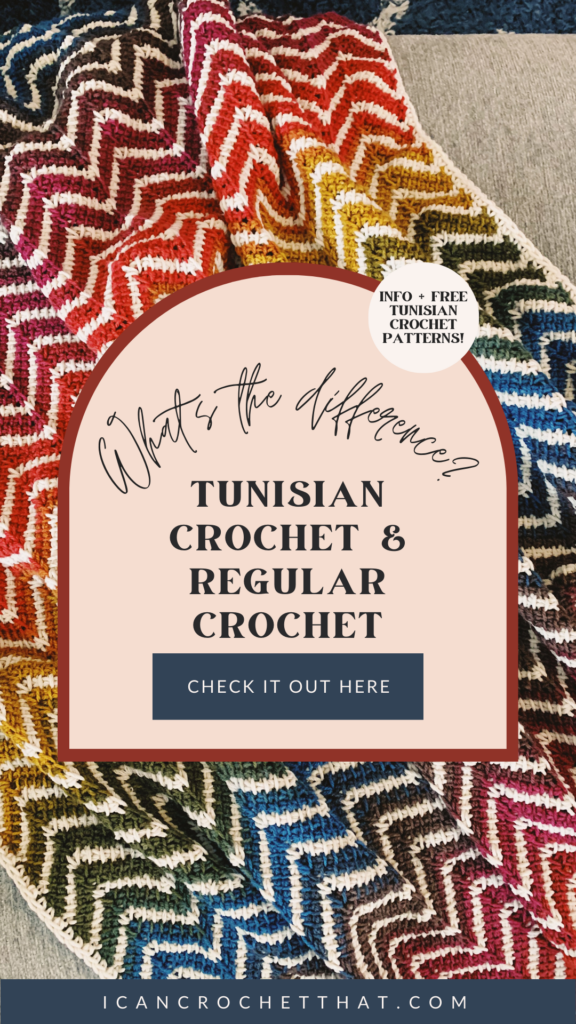
Embracing the Beauty of Both Tunisian and Regular Crochet
Having journeyed together through the intricacies of Tunisian crochet and regular crochet, it's clear that both these techniques bring unique flavors to the table, and each has its place in our crochet toolkit.
Tunisian crochet stands out with its special long hooks, distinctive 'forward pass' and 'return pass' methods, and unique stitches resulting in a dense, woven-like fabric.
It's a world filled with texture and warm, cozy projects, ranging from simple scarves to intricate sweaters. If you're seeking a crochet technique that can mimic the look of knitted fabric, or if you're just after a denser, more solid fabric, Tunisian crochet might be your new go-to.
On the other hand, regular crochet continues to be a beloved craft for its variety of stitches, flexibility, and the lacy, open fabric it creates. It’s versatile, easy to correct mistakes, and offers a wide range of project possibilities.
The choice between Tunisian and regular crochet is less about superiority and more about your final product's desired texture, drape, and aesthetic. It's the project that often dictates the technique and not the other way around.
Keep exploring, keep learning, and most importantly, keep crocheting. Here's to creating more beautiful pieces, one stitch at a time!

